2013 FORD POLICE INTERCEPTOR SEDAN child seat
[x] Cancel search: child seatPage 21 of 375

Types of Booster Seats
•Backless booster seats
If your backless booster seat has a removable shield, remove the shield.
If a vehicle seating position has a low seat back or no head restraint, a
backless booster seat may place your child’s head (as measured at the
tops of the ears) above the top of the seat. In this case, move the
backless booster to another seating position with a higher seat back or
head restraint and lap/shoulder belts, or consider using a high back
booster seat.
•High back booster seats
If, with a backless booster seat, you cannot find a seating position that
adequately supports your child’s head, a high back booster seat would be
a better choice.
Children and booster seats vary in size and shape. Choose a booster that
keeps the lap belt low and snug across the hips, never up across the
stomach, and lets you adjust the shoulder belt to cross the chest and rest
snugly near the center of the shoulder. The following drawings compare
the ideal fit (center) to a shoulder belt uncomfortably close to the neck
and a shoulder belt that could slip off the shoulder. The drawings also
show how the lap belt should be low and snug across the child’s hips.
Child Safety21
2013 Police(pol)
Owners Guide gf, 2nd Printing
USA(fus)
Page 22 of 375
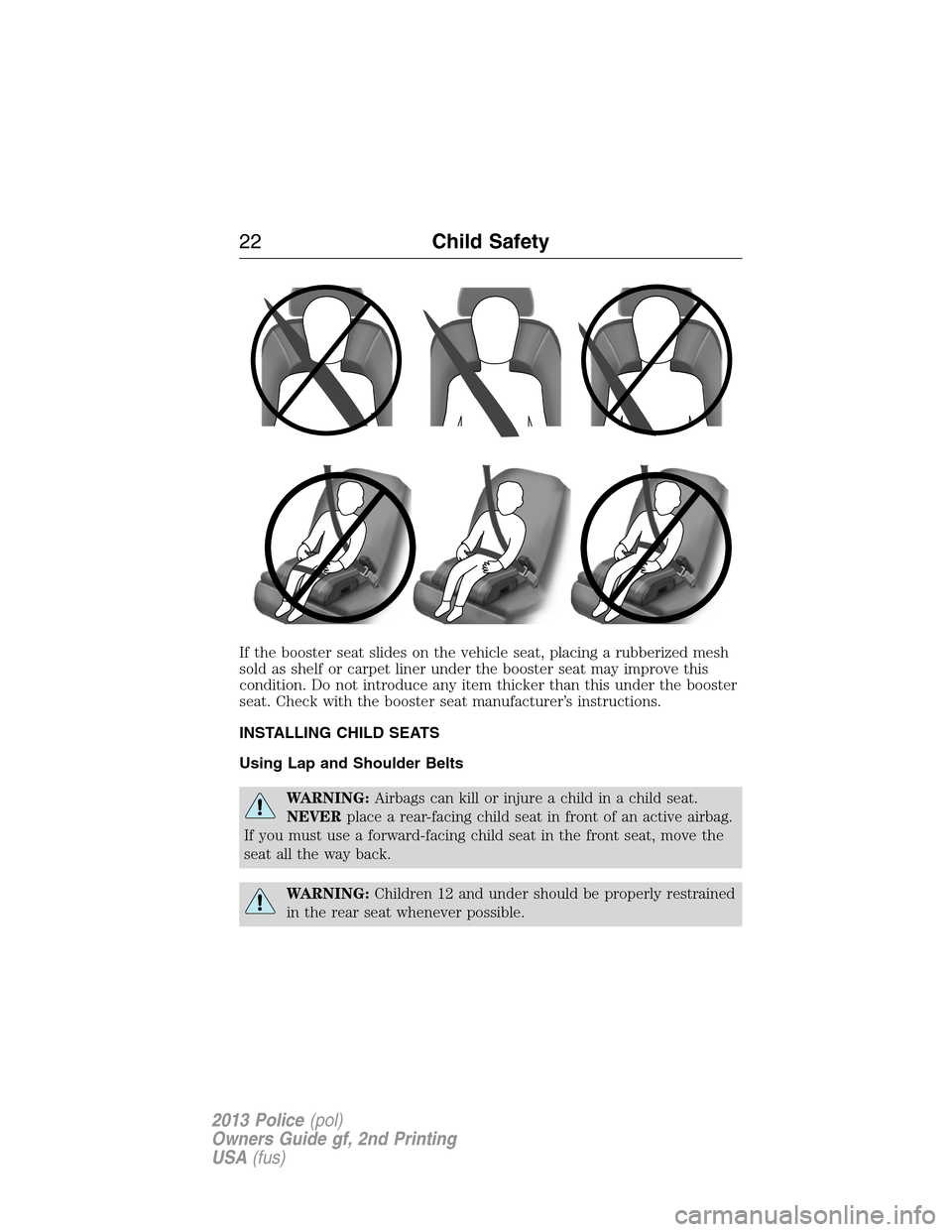
If the booster seat slides on the vehicle seat, placing a rubberized mesh
sold as shelf or carpet liner under the booster seat may improve this
condition. Do not introduce any item thicker than this under the booster
seat. Check with the booster seat manufacturer’s instructions.
INSTALLING CHILD SEATS
Using Lap and Shoulder Belts
WARNING:Airbags can kill or injure a child in a child seat.
NEVERplace a rear-facing child seat in front of an active airbag.
If you must use a forward-facing child seat in the front seat, move the
seat all the way back.
WARNING:Children 12 and under should be properly restrained
in the rear seat whenever possible.
22Child Safety
2013 Police(pol)
Owners Guide gf, 2nd Printing
USA(fus)
Page 23 of 375

WARNING:Depending on where you secure a child restraint,
and depending on the child restraint design, you may block
access to certain safety belt buckle assemblies and/or LATCH lower
anchors, rendering those features potentially unusable. To avoid risk of
injury, occupants should only use seating positions where they are able
to be properly restrained.
When installing a child safety seat with combination lap and shoulder belts:
•Use the correct safety belt buckle for that seating position.
•
Insert the belt tongue into the proper buckle until you hear a snap and
feel it latch. Make sure the tongue is securely fastened in the buckle.
•Keep the buckle release button pointing up and away from the safety
seat, with the tongue between the child seat and the release button,
to prevent accidental unbuckling.
•Place vehicle seat back in upright position.
•For second row seating positions, if needed, the recliner may be
adjusted slightly to improve child seat fit. If needed the head
restraints may be removed.
•Put the safety belt in the automatic locking mode. See Step 5. This
vehicle does not require the use of a locking clip.
Perform the following steps when installing the child seat with
combination lap/shoulder belts:
Note:Although the child seat illustrated is a forward facing child seat,
the steps are the same for installing a rear facing child seat.
Note:Follow all instructions provided by the manufacturer of the child
restraint regarding the necessary and proper use of the Lock-off device.
In some instances these devices have been provided only for use in
vehicles with safety belt systems that would otherwise require a locking
clip. This vehicle does not require the use of a locking clip.
Child Safety23
2013 Police(pol)
Owners Guide gf, 2nd Printing
USA(fus)
Page 24 of 375
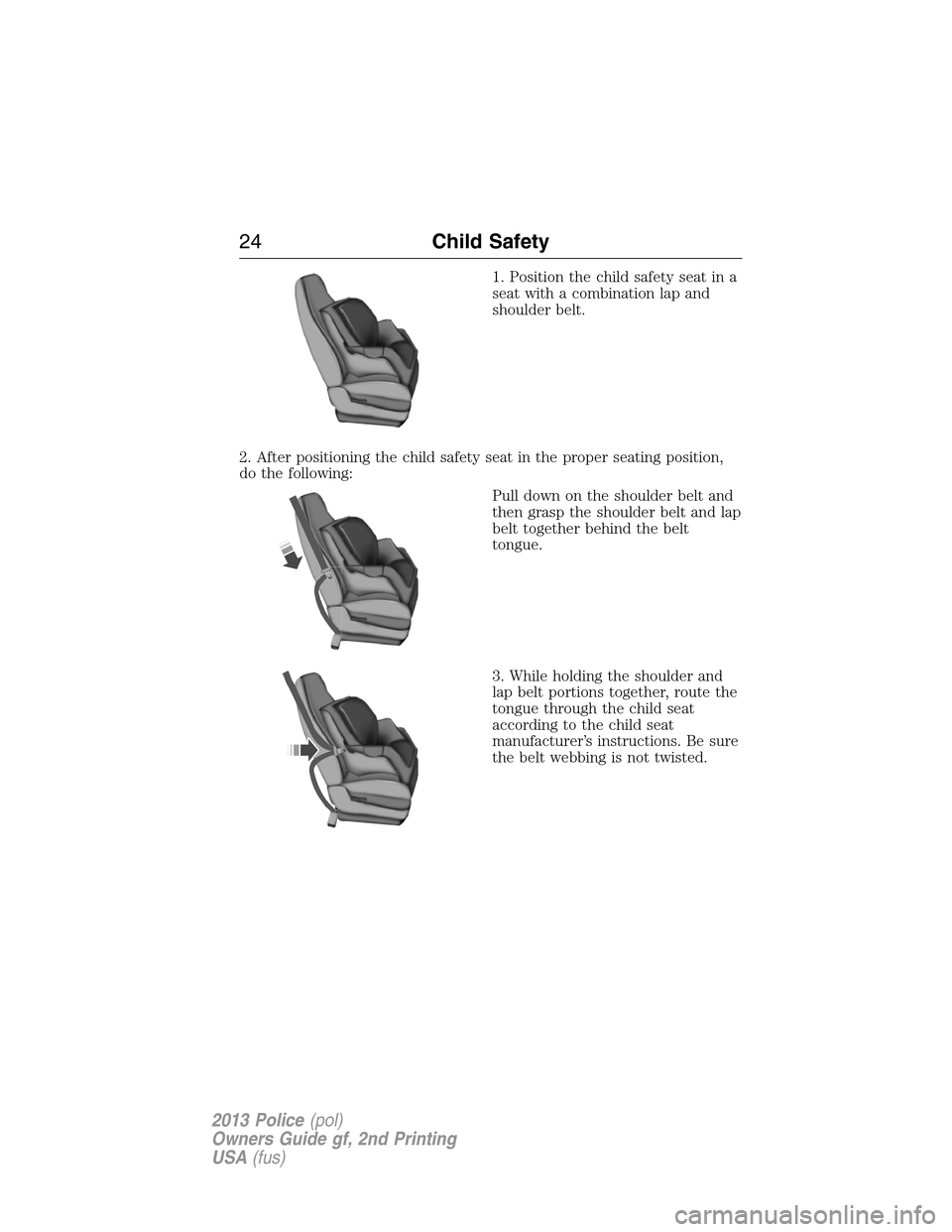
1. Position the child safety seat in a
seat with a combination lap and
shoulder belt.
2. After positioning the child safety seat in the proper seating position,
do the following:
Pull down on the shoulder belt and
then grasp the shoulder belt and lap
belt together behind the belt
tongue.
3. While holding the shoulder and
lap belt portions together, route the
tongue through the child seat
according to the child seat
manufacturer’s instructions. Be sure
the belt webbing is not twisted.
24Child Safety
2013 Police(pol)
Owners Guide gf, 2nd Printing
USA(fus)
Page 25 of 375
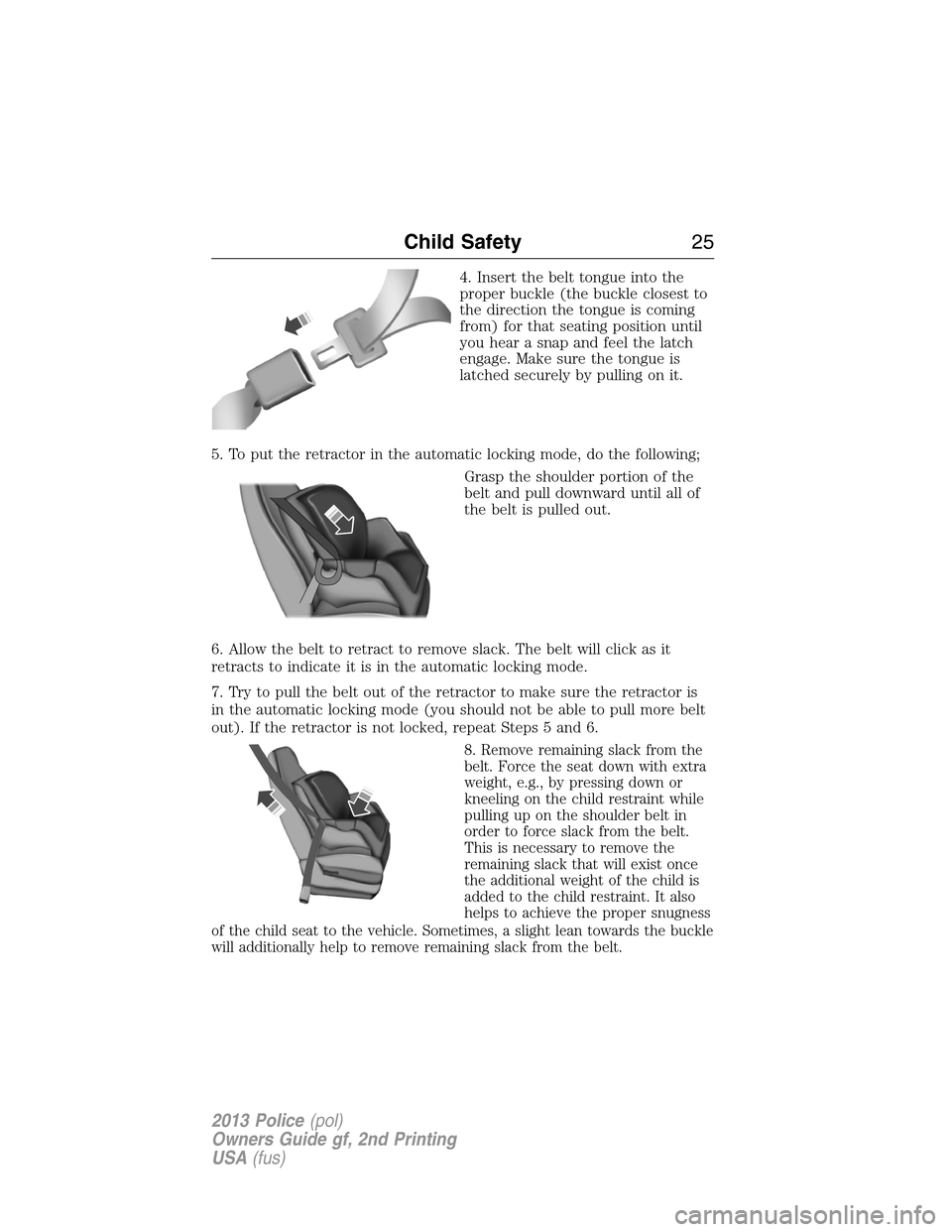
4. Insert the belt tongue into the
proper buckle (the buckle closest to
the direction the tongue is coming
from) for that seating position until
you hear a snap and feel the latch
engage. Make sure the tongue is
latched securely by pulling on it.
5. To put the retractor in the automatic locking mode, do the following;
Grasp the shoulder portion of the
belt and pull downward until all of
the belt is pulled out.
6. Allow the belt to retract to remove slack. The belt will click as it
retracts to indicate it is in the automatic locking mode.
7. Try to pull the belt out of the retractor to make sure the retractor is
in the automatic locking mode (you should not be able to pull more belt
out). If the retractor is not locked, repeat Steps 5 and 6.
8. Remove remaining slack from the
belt. Force the seat down with extra
weight, e.g., by pressing down or
kneeling on the child restraint while
pulling up on the shoulder belt in
order to force slack from the belt.
This is necessary to remove the
remaining slack that will exist once
the additional weight of the child is
added to the child restraint. It also
helps to achieve the proper snugness
of the child seat to the vehicle. Sometimes, a slight lean towards the buckle
will additionally help to remove remaining slack from the belt.
Child Safety25
2013 Police(pol)
Owners Guide gf, 2nd Printing
USA(fus)
Page 26 of 375

9. Attach the tether strap (if the child seat is equipped). SeeUsing
Tether Strapslater in this chapter.
10. Before placing the child in the
seat, forcibly move the seat forward
and back to make sure the seat is
securely held in place. To check
this, grab the seat at the belt path
and attempt to move it side to side
and forward and back. There should
be no more than 1 inch (2.5 cm) of
movement for proper installation.
Ford recommends checking with a NHTSA Certified Child Passenger
Safety Technician (CPST) to make certain the child restraint is properly
installed. In Canada, check with your local St. John Ambulance office for
referral to a CPST.
Using Lower Anchors and Tethers for CHildren (LATCH)
WARNING:Never attach two child safety seats to the same
anchor. In a crash, one anchor may not be strong enough to hold
two child safety seat attachments and may break, causing serious injury
or death.
WARNING:Depending on where you secure a child restraint,
and depending on the child restraint design, you may block
access to certain safety belt buckle assemblies and/or LATCH lower
anchors, rendering those features potentially unusable. To avoid risk of
injury, occupants should only use seating positions where they are able
to be properly restrained.
The LATCH system is composed of three vehicle anchor points: two
lower anchors located where the vehicle seat back and seat cushion meet
(called the seat bight) and one top tether anchor located behind that
seating position.
LATCH compatible child safety seats have two rigid or webbing mounted
attachments that connect to the two lower anchors at the LATCH
equipped seating positions in your vehicle. This type of attachment
method eliminates the need to use safety belts to attach the child seat,
however the safety belt can still be used to attach the child seat. For
26Child Safety
2013 Police(pol)
Owners Guide gf, 2nd Printing
USA(fus)
Page 27 of 375
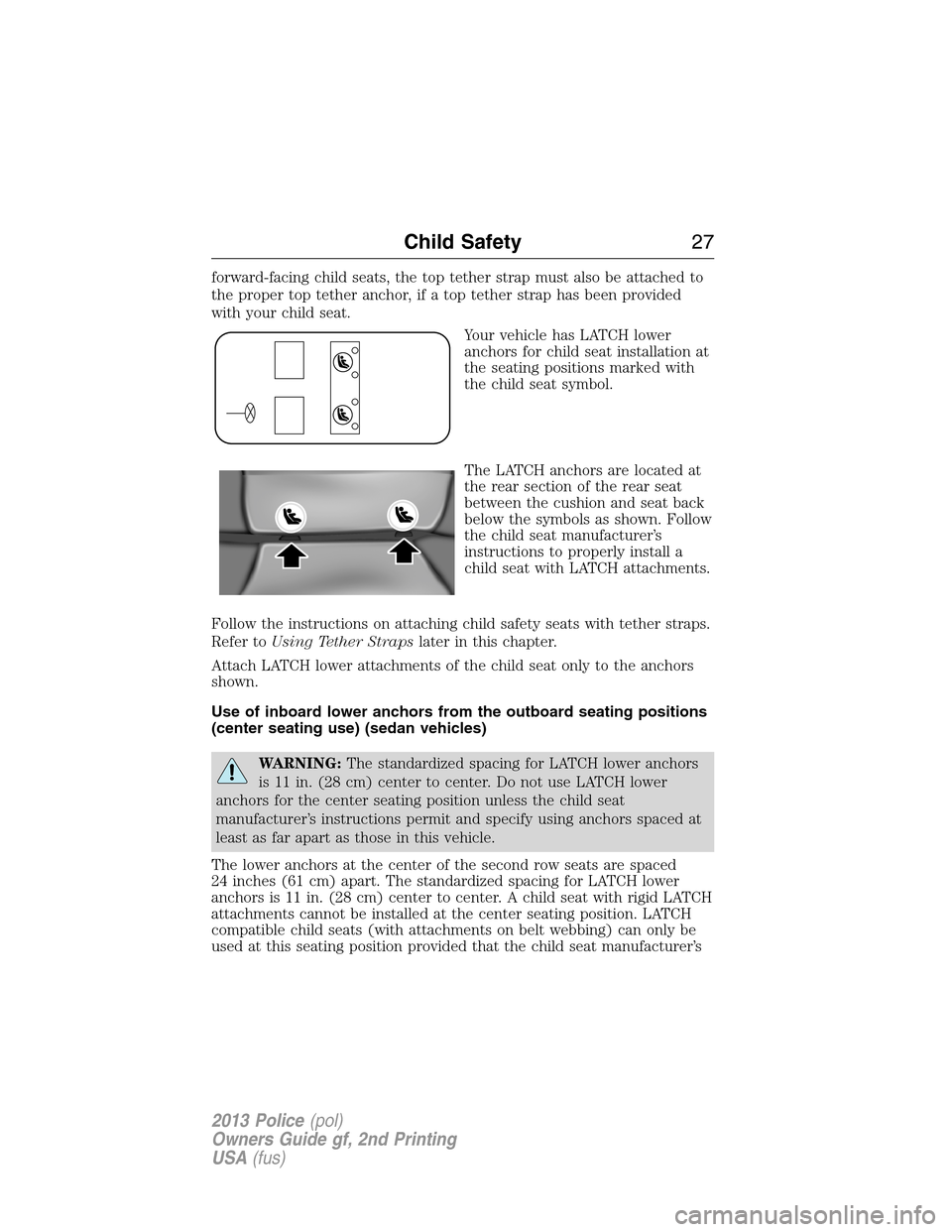
forward-facing child seats, the top tether strap must also be attached to
the proper top tether anchor, if a top tether strap has been provided
with your child seat.
Your vehicle has LATCH lower
anchors for child seat installation at
the seating positions marked with
the child seat symbol.
The LATCH anchors are located at
the rear section of the rear seat
between the cushion and seat back
below the symbols as shown. Follow
the child seat manufacturer’s
instructions to properly install a
child seat with LATCH attachments.
Follow the instructions on attaching child safety seats with tether straps.
Refer toUsing Tether Strapslater in this chapter.
Attach LATCH lower attachments of the child seat only to the anchors
shown.
Use of inboard lower anchors from the outboard seating positions
(center seating use) (sedan vehicles)
WARNING:The standardized spacing for LATCH lower anchors
is 11 in. (28 cm) center to center. Do not use LATCH lower
anchors for the center seating position unless the child seat
manufacturer’s instructions permit and specify using anchors spaced at
least as far apart as those in this vehicle.
The lower anchors at the center of the second row seats are spaced
24 inches (61 cm) apart. The standardized spacing for LATCH lower
anchors is 11 in. (28 cm) center to center. A child seat with rigid LATCH
attachments cannot be installed at the center seating position. LATCH
compatible child seats (with attachments on belt webbing) can only be
used at this seating position provided that the child seat manufacturer’s
Child Safety27
2013 Police(pol)
Owners Guide gf, 2nd Printing
USA(fus)
Page 28 of 375
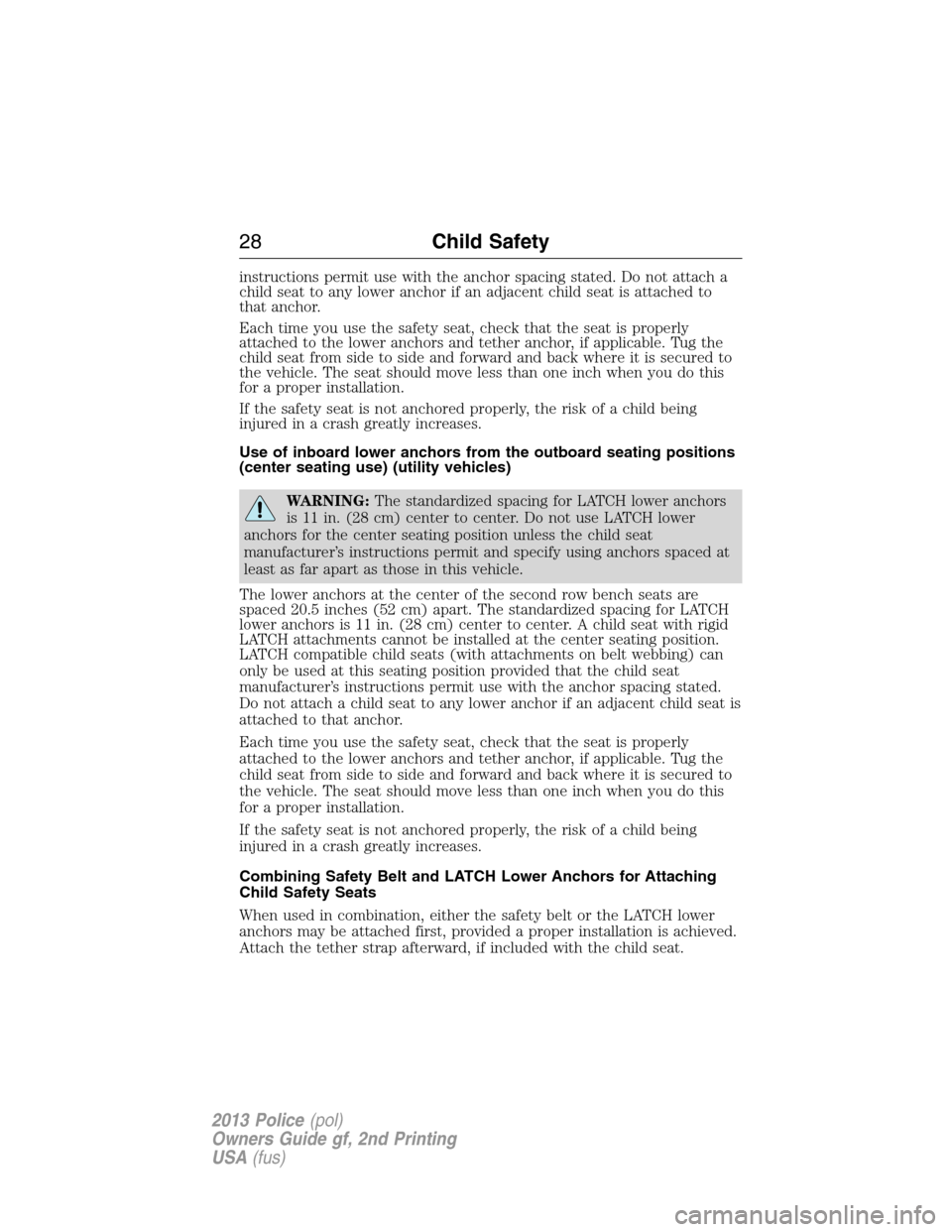
instructions permit use with the anchor spacing stated. Do not attach a
child seat to any lower anchor if an adjacent child seat is attached to
that anchor.
Each time you use the safety seat, check that the seat is properly
attached to the lower anchors and tether anchor, if applicable. Tug the
child seat from side to side and forward and back where it is secured to
the vehicle. The seat should move less than one inch when you do this
for a proper installation.
If the safety seat is not anchored properly, the risk of a child being
injured in a crash greatly increases.
Use of inboard lower anchors from the outboard seating positions
(center seating use) (utility vehicles)
WARNING:The standardized spacing for LATCH lower anchors
is 11 in. (28 cm) center to center. Do not use LATCH lower
anchors for the center seating position unless the child seat
manufacturer’s instructions permit and specify using anchors spaced at
least as far apart as those in this vehicle.
The lower anchors at the center of the second row bench seats are
spaced 20.5 inches (52 cm) apart. The standardized spacing for LATCH
lower anchors is 11 in. (28 cm) center to center. A child seat with rigid
LATCH attachments cannot be installed at the center seating position.
LATCH compatible child seats (with attachments on belt webbing) can
only be used at this seating position provided that the child seat
manufacturer’s instructions permit use with the anchor spacing stated.
Do not attach a child seat to any lower anchor if an adjacent child seat is
attached to that anchor.
Each time you use the safety seat, check that the seat is properly
attached to the lower anchors and tether anchor, if applicable. Tug the
child seat from side to side and forward and back where it is secured to
the vehicle. The seat should move less than one inch when you do this
for a proper installation.
If the safety seat is not anchored properly, the risk of a child being
injured in a crash greatly increases.
Combining Safety Belt and LATCH Lower Anchors for Attaching
Child Safety Seats
When used in combination, either the safety belt or the LATCH lower
anchors may be attached first, provided a proper installation is achieved.
Attach the tether strap afterward, if included with the child seat.
28Child Safety
2013 Police(pol)
Owners Guide gf, 2nd Printing
USA(fus)